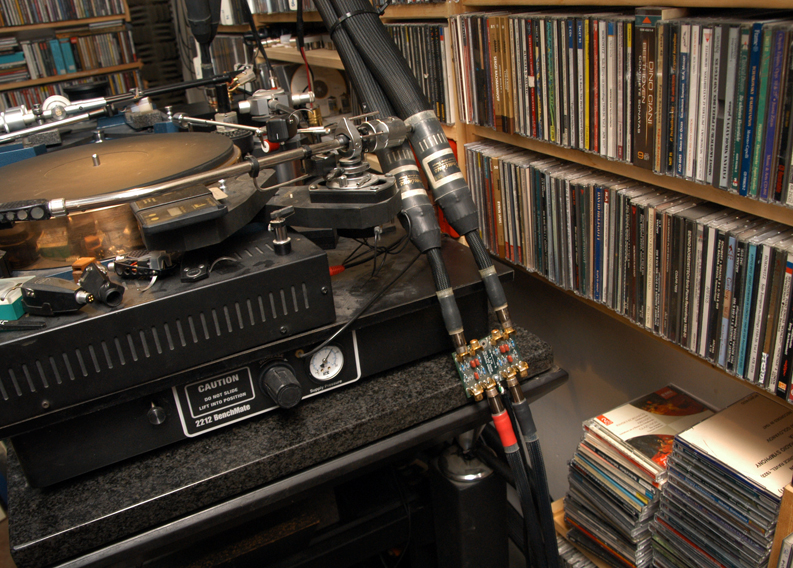 Brian Clark wrote: Brian Clark wrote: |
| Whereas I do. deParavicini's worked on designs in Japan over several years and became familiar with the research going on there in the Seventies which culminated in identifying the HD decay-spectrum as a key indicator for "musicality". I.e. a monotonically decreasing level as order increased such that each HD component masked the following component. This occurs naturally in a single triode operating under normal conditions. When I simulated the 834P circuit two things were obvious - the level of THD was high but the aforesaid decay spectrum approximated that of a single triode valve.
For what it's worth and acknowledging it is part of a bigger picture of course. |
|
Brian, that is very interesting and I did not know it about Paravicini. Was it intentionally or now is a different matter… Whatever it is it works…
I am going tell you, Brian, and to other something ease that might blow your socks off, if you are associated or talk with Paravicini then feel free to forward this message to him. So, what would it be?
Well, the “musicality” and “humanity” of this Paravicini-based phonocorrector (whatever reasons are) turned out to be so astonishing that it becomes dazzling. Do you know that my new 834PTF phonocorrector has an ability to actually override the musicality of amusical medioum and to recover/recuperate the poisoned Sound? Do I sound too hallucinogenic, do I? The reality is that I am not hallucinogenic and that I very clearly, cognitively and rationally see the things. Let me to explain.
First of all what I’m saying does not mean to convince anybody. It is internet, my site, and I can run my month on any subject with any degree of credibility and trustworthiness. However, I do not think I was ever was spotted lying or to be deceptive (I can testify that I was stupid in some occasions but it was not deliberate and was just due to ignorance). So, I’m not lying now – the “End of Life Phonostage” does have some internal magic that makes Sound passing via the phonocorrector more interesting in comparing to (are you ready for this?)… the sound that did not pass via the phonocorrector. OK, now I shell make a long Mahler’s after-Allegro-Maestoso pose…
One of the many reasons why I do not write audio-reviews because the task to convince the Moronic audio public is too simple. In my personal audio life I need to convince myself – a way much more complicated and much difficult task. If you read my post “Reviewing preamps by imbeciles”:
http://www.romythecat.com/Forums/ShowPost.aspx?PostID=2589
Then you understand my attitude toward to the way how I see preamps. OK, why a phonocorrector shell be different? I use the same demands to RIAA corrector as I have to preamp. So, for a few years I practice the to run the inverted RIAA curve to phonostage and evaluate how the anti-RIAA-phonocorrector tandem competes with sound to the original source that I use to feed the anti-RIAA network. There is always a very specific differences but if you trained to do it and well understand the permanent limitations of your anti-RIAA network then you can say a LOT about the sound of a tested phonocorrector.
So, since end up the “End of Life Phonostage” I spent some time to listen it after the anti-RIAA. I always burn in phonostage with anti-RIAA sound as feeding phonostage with straight 3mV not RIAA sound obliterate lower basses for next 3-4 days. So, I am running the following chain:
88/24 files from DAW - Linx16 - Lavry 924 – Placette Active – Melquiades – Macondo (with Dominus Rev B everywhere)
Against the following chain:
88/24 files from DAW - Linx16 - Lavry 924 – Hagerman’s iRIAA (600R in -60dB out) - End of Life Phonostage - Placette Active – Melquiades – Macondo (with Dominus Rev B everywhere but using Proteus between Lavry and Hagerman’s filter)

What do you think the difference in sound is? There are some very minute issuers here and there - it would be hard to comment about them to readers who not tuned to those evaluations BUT the shocking reality is that I generally prefer in term of “musicality” and “humanity” the sound that actually passes through the End of Life Phonostage. It acts as “harmonic’ catalyzer” – very pleasant effect indeed. Perhaps it injects some fat second harmonics into sound but it does NOT sound like ONLY that. I do not know what it does but the effect is there and it is very very very very positive. I would also say that the air-caped 834PTF is insultingly transparent in this test. I can only assure that 100% of people out there would listen that sound coming via the anti-RIAA-phonocorrector tandem with no clue that they were listening the RIAA double-inverted sound. So, whoever Paravicini did with his “HD decay-spectrum as a key indicator" looks like works…
Rgs, Romy the happy Cat

"I wish I could score everything for horns." - Richard Wagner. "Our writing equipment takes part in the forming of our thoughts." - Friedrich Nietzsche